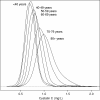Age and cystatin C in healthy adults: a collaborative study
- PMID: 19749145
- PMCID: PMC2904248
- DOI: 10.1093/ndt/gfp474
Age and cystatin C in healthy adults: a collaborative study
Abstract
Background: Kidney function declines with age, but a substantial portion of this decline has been attributed to the higher prevalence of risk factors for kidney disease at older ages. The effect of age on kidney function has not been well described in a healthy population across a wide age spectrum.
Methods: The authors pooled individual-level cross-sectional data from 18 253 persons aged 28-100 years in four studies: the Cardiovascular Health Study; the Health, Aging and Body Composition Study; the Multi-Ethnic Study of Atherosclerosis and the Prevention of Renal and Vascular End-Stage Disease cohort. Kidney function was measured by cystatin C. Clinical risk factors for kidney disease included diabetes, hypertension, obesity, smoking, coronary heart disease, cerebrovascular disease, peripheral arterial disease and heart failure.
Results: Across the age range, there was a strong, non-linear association of age with cystatin C concentration. This association was substantial, even among participants free of clinical risk factors for kidney disease; mean cystatin C levels were 46% higher in participants 80 and older compared with those <40 years (1.06 versus 0.72 mg/L, P < 0.001). Participants with one or more risk factors had higher cystatin C concentrations for a given age, and the age association was slightly stronger (P < 0.001 for age and risk factor interaction).
Conclusions: There is a strong, non-linear association of age with kidney function, even in healthy individuals. An important area for research will be to investigate the mechanisms that lead to deterioration of kidney function in apparently healthy persons.
Figures



Similar articles
-
Hypertension and low HDL cholesterol were associated with reduced kidney function across the age spectrum: a collaborative study.Ann Epidemiol. 2013 Mar;23(3):106-11. doi: 10.1016/j.annepidem.2012.12.004. Epub 2013 Jan 10. Ann Epidemiol. 2013. PMID: 23313266 Free PMC article.
-
Cystatin C and carotid intima-media thickness in asymptomatic adults: the Multi-Ethnic Study of Atherosclerosis (MESA).Am J Kidney Dis. 2009 Mar;53(3):389-98. doi: 10.1053/j.ajkd.2008.06.025. Epub 2008 Sep 27. Am J Kidney Dis. 2009. PMID: 18823684 Free PMC article.
-
Accuracy of glomerular filtration rate estimation using creatinine and cystatin C for identifying and monitoring moderate chronic kidney disease: the eGFR-C study.Health Technol Assess. 2024 Jul;28(35):1-169. doi: 10.3310/HYHN1078. Health Technol Assess. 2024. PMID: 39056437 Free PMC article.
-
The association between creatinine versus cystatin C-based eGFR and cardiovascular risk in children with chronic kidney disease using a modified PDAY risk score.Pediatr Nephrol. 2017 Aug;32(8):1457-1463. doi: 10.1007/s00467-017-3683-7. Epub 2017 May 8. Pediatr Nephrol. 2017. PMID: 28484878
-
Folic acid supplementation and malaria susceptibility and severity among people taking antifolate antimalarial drugs in endemic areas.Cochrane Database Syst Rev. 2022 Feb 1;2(2022):CD014217. doi: 10.1002/14651858.CD014217. Cochrane Database Syst Rev. 2022. PMID: 36321557 Free PMC article.
Cited by
-
A framework for selection of blood-based biomarkers for geroscience-guided clinical trials: report from the TAME Biomarkers Workgroup.Geroscience. 2018 Dec;40(5-6):419-436. doi: 10.1007/s11357-018-0042-y. Epub 2018 Aug 27. Geroscience. 2018. PMID: 30151729 Free PMC article. Review.
-
Association Between Cystatin C and 20-Year Cumulative Incidence of Hearing Impairment in the Epidemiology of Hearing Loss Study.JAMA Otolaryngol Head Neck Surg. 2018 Jun 1;144(6):469-474. doi: 10.1001/jamaoto.2018.0041. JAMA Otolaryngol Head Neck Surg. 2018. PMID: 29710267 Free PMC article.
-
Cystatin C and cystatin SN as possible soluble tumor markers in malignant uveal melanoma.Radiol Oncol. 2021 Dec 22;56(1):83-91. doi: 10.2478/raon-2021-0049. Radiol Oncol. 2021. PMID: 34957724 Free PMC article.
-
Subjective Age and Cystatin C Among Older Adults.J Gerontol B Psychol Sci Soc Sci. 2019 Feb 15;74(3):382-388. doi: 10.1093/geronb/gbx124. J Gerontol B Psychol Sci Soc Sci. 2019. PMID: 29045722 Free PMC article.
-
Discrepant glomerular filtration rate trends from creatinine and cystatin C in patients with chronic kidney disease: results from the KNOW-CKD cohort.BMC Nephrol. 2020 Jul 16;21(1):280. doi: 10.1186/s12882-020-01932-4. BMC Nephrol. 2020. PMID: 32677901 Free PMC article.
References
-
- National Institute of Diabetes and Digestive and Kidney Diseases, National Institutes of Health. USRDS 2008. 2007 Annual Data Report. Atlas of End-Stage Renal Disease in the United States.
-
- Coresh J, Selvin E, Stevens LA, et al. Prevalence of chronic kidney disease in the United States. JAMA. 2007;298:2038–2047. - PubMed
-
- Wesson LG. Renal hemodynamics in physiological states. In: Wesson LG, editor. Physiology of the Human Kidney. New York: Grune and Stratton; 1969. pp. 96–108.
-
- Zhou XJ, Rakheja D, Yu X, et al. The aging kidney. Kidney Int. 2008;74:710–720. - PubMed
-
- Fliser D. Ren sanus in corpore sano: the myth of the inexorable decline of renal function with senescence. Nephrol Dial Transplant. 2005;20:482–485. - PubMed
Publication types
MeSH terms
Substances
Grants and funding
- R01AG027002/AG/NIA NIH HHS/United States
- N01 HC085086/HC/NHLBI NIH HHS/United States
- N01-AG-6-2101/AG/NIA NIH HHS/United States
- U01 HL080295/HL/NHLBI NIH HHS/United States
- N01 HC095169/HL/NHLBI NIH HHS/United States
- N01-HC-95159/HC/NHLBI NIH HHS/United States
- N01-HC-95165/HC/NHLBI NIH HHS/United States
- R01 HL063963/HL/NHLBI NIH HHS/United States
- N01 HC-55222/HC/NHLBI NIH HHS/United States
- R01-HL-63963-01A1/HL/NHLBI NIH HHS/United States
- ImNIH/Intramural NIH HHS/United States
- T32 DK007791/DK/NIDDK NIH HHS/United States
- N01 HC075150/HL/NHLBI NIH HHS/United States
- N01 HC035129/HC/NHLBI NIH HHS/United States
- N01-AG-6-2103/AG/NIA NIH HHS/United States
- N01 HC015103/HC/NHLBI NIH HHS/United States
- N01 HC085086/HL/NHLBI NIH HHS/United States
- N01-HC-85086/HC/NHLBI NIH HHS/United States
- N01 HC095159/HL/NHLBI NIH HHS/United States
- N01 HC055222/HL/NHLBI NIH HHS/United States
- N01-HC-95169/HC/NHLBI NIH HHS/United States
- DK52866/DK/NIDDK NIH HHS/United States
- N01 HC085079/HL/NHLBI NIH HHS/United States
- N01-HC-75150/HC/NHLBI NIH HHS/United States
- N01-AG-6-2106/AG/NIA NIH HHS/United States
- R01 AG027002/AG/NIA NIH HHS/United States
- N01-HC-85079/HC/NHLBI NIH HHS/United States
- T32DK07791/DK/NIDDK NIH HHS/United States
- N01 HC095165/HL/NHLBI NIH HHS/United States
- N01 HC045133/HC/NHLBI NIH HHS/United States
LinkOut - more resources
Full Text Sources
Molecular Biology Databases

